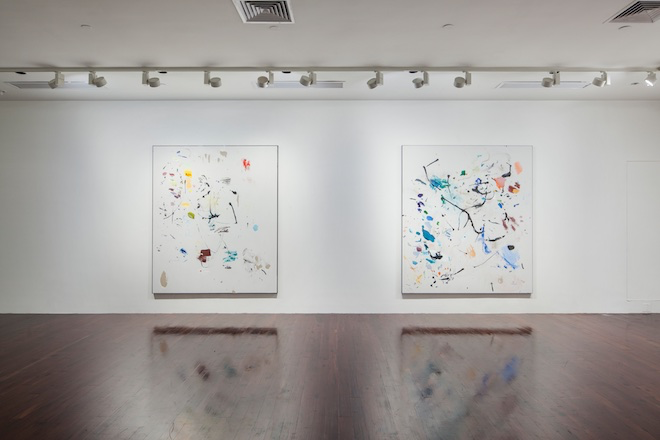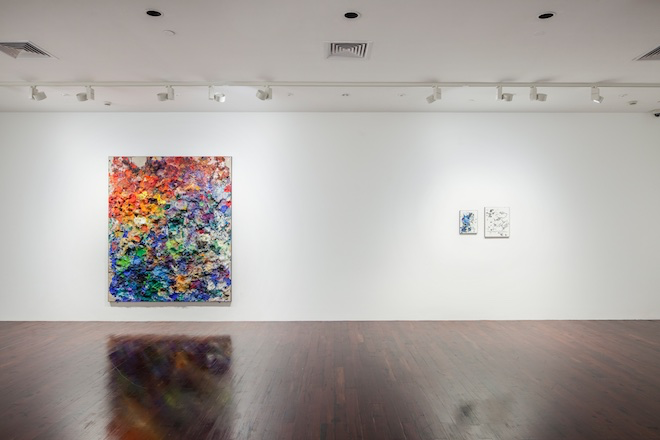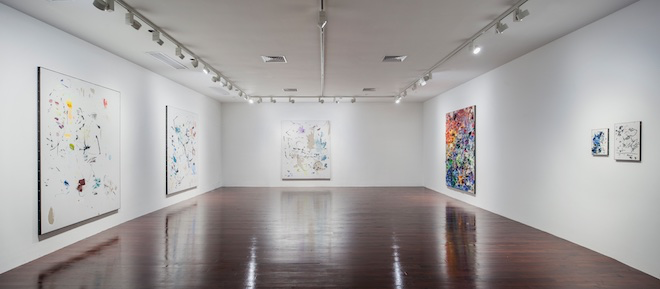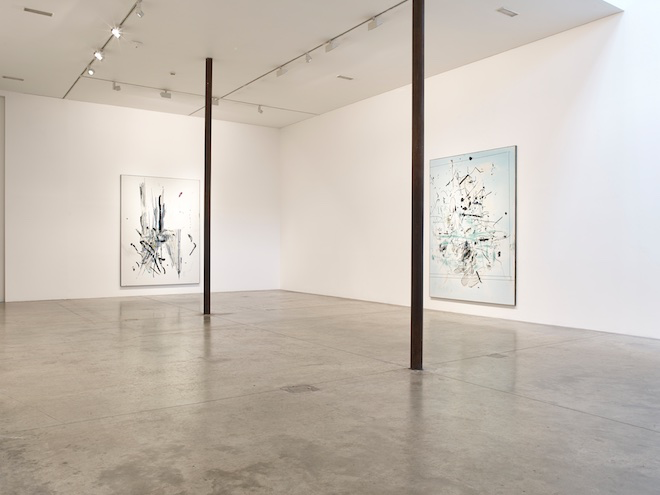by Chris Moore 墨虎恺
Introduction
Abstract painting has seen a dramatic resurgence in the last 10 years but skepticism remains strong (Hal Foster’s essay against expressionism still echoes loudly) and even justified (hence the withering critiques of “Zombie Abstraction”). Beyond the merely superficial and pedestrian however, the serious new abstractions—for there is no dominant trend—are often accommodated within existing debates about conceptualism, the copy and mechanisation (the clinical print paintings of Wade Guyton and the performance-developed painting of Zhao Yao are good examples). This still does not account though, for the developing schism between conceptual art and non-conceptual painting, whether abstract or figurative.
Yet abstraction can offer an escape from the impossible rigmarole of avant-garde innovation, the infinitely parsed nuances of difference from past triumphs. In this direction, the physical attributes of painting and its formal and historical aspects are treated equally as media. It becomes an open discourse, not a statement.

(Courtesy the Artist and Victoria Miro, London © Secundino Hernández)
This brings us to Secundino Hernández. Born in 1975, his painting practice involves a process—a recording, really—of marking and correction, interleafed with quotes and examinations of artists as diverse as El Greco, Velázquez and Picabia. In September, Hernández’s first show in Asia opened at the Yuz Museum in Shanghai. Randian met Secundino at Das Literaturhaus, one of West Berlin’s oldest cafes, to discuss his approach to the problems of painting now.
Interview with Scundino Hernández at Das Literaturhaus
Chris Moore: I have been looking at lots of your works and one of the things I find interesting are your references to El Greco.
Secundino Hernández: Yes, also, among others.
When I was in Rome, I began to think about basic questions, like: why do I use these references? Where am I coming from, if I really know my roots? Because as an artist, you could be based in Berlin but then your references could be American artists, or British art or Australian or whatever. I started thinking about this and [as] I was also living near the library in the Spanish Academy, it was very easy each day to study every artist. And I understood, more or less, that I had to develop my own language but also [to] be conscious of my [artistic] ancestors. I began a conversation, within the art, without any idea of time—I don’t care if El Greco is [from] 400 years ago or yesterday, because I think he is also very contemporary.
Also, at that time, in the studio I liked to mix my vision as a spectator with my position as a creator. I think it is very important to have this double position. Everything gets richer! The experience of art gets richer!
So then, when I made these interactions with El Greco, they were made also because I had this experience as a spectator. Then I tried to understand better, as a painter, what he did—to develop my own relationship with him.

(Courtesy the Artist and Victoria Miro, London © Secundino Hernández)
How to read drawing
CM: Your works can appear disconnected at first sight. Perhaps it has a lot to do with drawing—one is not meant to look at the whole thing at once.
SH: Yes. You have to follow the whole composition step-by-step. It is like reading.
CM: Exactly, because the space between the marks is very important—which is crucial to drawing because drawing is about space.
SH: This aspect is very important in relation to my technique. For me, it is very important to understand how to transfer the [drawn] line to canvas, which is why I use different tubes [of paint], with different nozzles, and they make different lines, thick or thin. I use tubes like brushes. Then I could use the canvas like a sketchbook, like when you draw. That was the point: a good technical solution to transfer the idea of non-mature painting [the concept of sketching]—but! being all the time “painting” of course, because the line belongs to the language of drawing. When it is done with paint though, it is also painting. This is the game.
CM: Well, intellectually, it is drawing.
SH: I also like the idea that when you use your fingers to trace on the canvas, you are using your whole body to make the form of the painting.
CM: To scale-up from a preparatory design or sketch?
SH: Yes but not only that—it is performative. That is why I have different thicknesses of nozzles [on the paint tubes]. Here [with a drawing] you are moving your hands, your fingers, but here [with the canvas] you are using your whole body. Action painting is not something I invented, of course!

(Courtesy the Artist and Victoria Miro, London © Secundino Hernández)
CM: When you are tracing, though, it is not exact.
SH: Sometimes I am very sharp, very precise, and sometimes very open. As you have seen though, there are also these other paintings that belong to color. When I was painting around 2005–2007, I started to introduce the memory of the process into the surface of the canvas. I started to mix colors and to clean brushes into the surface. So everything was part of the process and part of the painting itself. That is why you see thick color and mixed color—I wipe my fingers on it, whatever. So it was nice to see the relations between what I wanted to paint, what I wanted to represent, but also how the painting was itself growing, physically.
[Hernández also creates thick, colorful impasto works that recall abstract expressionists like Hans Hoffman (1880-1966) and Joan Mitchell (1925-1992)]
CM: You often leave the original white surface exposed. Sometimes you add a flat area; maybe you covered over something that was there. You leave the whole history of the process of making the painting exposed.
SH: Honestly, I am not so worried about the process, but it’s true that in my production it is very important, because when I think deeply about what I am doing, it is very much related to the process. I don’t like process artists, to be honest. They are about the technique or the materials. It is true though that everything comes out of the process of how you make the painting.
CM: Process should be one of the media in painting, as opposed to the end in itself.
SH: You are right!
For me, it’s important to remark because, while I am not terribly interested in process in itself, I am interested in the process of how a painting is built—constructed.
So, after this idea, what I was most interested in was the relationship between line and fields of color. This, for me, is the main thing, because it is the basic element of painting—the relationship between line and field.
CM: “Field” [an area within the painting] or color?
SH: Field is, for me, also related to color.
CM: But no part of the painting dominates another part. In that sense, they are “all-over” paintings.
SH: It could also be line or also color. I have paintings too that look like palette paintings. This combination, for me, is the way to paint, but I also have to have the elements to paint what I want to—the figure, abstraction.
CM: Well, that’s another point, because on first seeing your paintings, there’s this idea that they’re just pure abstraction, but they’re not. Often they’re based in reality. Most obviously: there are figures.
El Greco & Picabia
SH: I want to return to what I was saying about El Greco and Picabia, because it is difficult to explain. What I paint is the painting painted but also the painting lived—“lived” like a spectator. So I paint where the paths cross, not only as a spectator but as an artist.
CM: The physical but also artistic crossover?
SH: Physical, and artistic…
CM: Well at the moment we’re dealing with the concept of the all-over: scale, space, time—very physical qualities—also in relation to how paintings are developed. So these abstract paintings are certainly dealing with the formal qualities, say, of a drawing, where you’ve got black marks upon a white surface, but you’re also dealing with this history of art—all the artists that have gone before you: El Greco, Picabia, and probably Miró.
SH:—and many others. What I also wanted to say with these images is that I am not “inventing from nothing”. I am conscious that I am coming from somewhere. I am respectful of the European painting tradition. I can’t pretend to come from nothing. More and more though, I am not so interested in this kind of interaction with other artists. At the end, it is only a pretext to go on with your works. I like the idea of how music was made in the ’60s, when people were sharing compositions, and you could have the same song played by The Kinks and Bob Dylan and others. That was nice, because everyone was playing the same music but in their own style, without any “complex”. Nowadays everyone tries to be original and some guys complain that, “everyone wants to copy my ideas”. Come on! It makes no sense! Everything is already invented! You can only offer your own perspective, your own filter of the whole thing.

(Courtesy the Artist and Victoria Miro, London © Secundino Hernández)
People don’t know
SH: Going back to why I think people [in the art world] don’t respect or like painting so much anymore—
CM: —really?
SH: —is that they don’t know. They have this idea that with painting, video, everything is all the same. They don’t think [about] how it is done, technically. They only see an image and say, “I like” or “I don’t like.” A long time ago, when everyone tried to paint, to use a brush and mix colors, people realized more the difficulties [of the painting discipline]. Now, I think this is lost, this understanding of how to read it. They don’t think about the technique, they only see the image or go to meta-pictorial ideas. But sometimes only to think about how it is done is more than enough.
CM: With other construction or assemblage, it is much more purely about the concept. With painting, the concept and the philosophical background are always tied to the physical execution. Now, obviously, there are people like Wade Guyton who print paintings, but it’s almost as if there’s a split happening in art. On one side, you’ve got the very conceptual art, and these conceptual guys can make paintings—
SH: Yeah, yeah—they can make everything! [Laughing] But a painter cannot make conceptual art, you know?
CM: Exactly! And then there are painters per se, but these are not equal. It’s like the traditions have split. Painting is becoming something unto itself. Sculpture has this crossover position but painting is by itself. … Possibly it is like a schism.
SH: Yes, that’s why I am not so worried anymore about having this conceptual background in the works, because what is happening in the surface of the painting is enough for me. It’s more that painting itself is a position. The artist is a position—the painter. It is not as necessary to explain so much; to have a deep pretext to, at the end of the day, make a painting.
Especially talking about abstraction, because if you have a figure or more narratives or subjects, it’s easier or different; not easier, but at least you have the reality where you can cut it and say “this is a tree”, “this is a glass of some paint or whatever”. But in abstraction, I find that people try to explain what you cannot explain. Come on, it’s only a painting, you know!
Interview conducted on Tuesday, September 22, 2015 at Das Literaturhaus, Fasanenstaße, Berlin
* Thanks to Victoria Miro Gallery for assistance in the preparation of this article.
Secundino Hernández “Entre Primavery Y Verano”
Yuz Project Room, Yuz Museum 余德耀美术馆 (中国上海徐汇区丰谷路35号余德耀美术馆 No.35, Fenggu Road, Xuhui District, Shanghai,China) Sept. 9–Oct.11, 2015
Victoria Miro Gallery will present new works by Secundino Hernández at frieze London.
Frieze London (Stand B3) 13 – 17 October 2015
Secundino Hernández “Today”
Krinzinger Galerie (Seilerstätte 16, 1010 Vienna) Sep. 17–Oct.31, 2015

(Courtesy the Artist and Victoria Miro, London © Secundino Hernández)